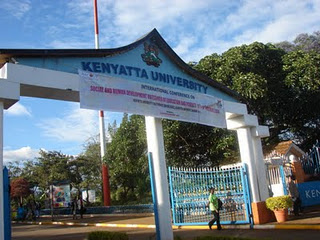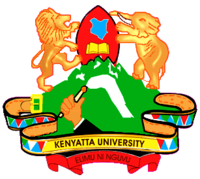|
History of Kenyatta University.
Kenyatta University is situated about 23 kilometres from the city of Nairobi on the Nairobi-Thika dual carriageway on 1,100 acres of land. The long journey to University status started in 1965 when the British Government handed over the Templer Barracks to the Kenya Government. These were converted into an institution of higher learning known as Kenyatta College. Initially, Kenyatta College was divided into two sections, the Secondary Education Division (SED) and the Teacher Education Division (TED). The Secondary Education Division had classes from Form I to Form VI. Forms I and IV and the Advanced level Arts classes were phased out in 1969 to give way to seven Advanced level Science classes which earned the institution high reputation for its excellent performance in the Advanced level examinations. It became the main supplier of undergraduates in Science oriented courses at the University of Nairobi where they performed extremely well. The Secondary Education Division was phased out in 1973. The first courses offered in the Teacher Education Division in 1965 were the three-year Post-Ordinary level Secondary Teacher’s Certificate [SI and a one-year post-Advanced Secondary Teacher’s Certificate (SA)]. Following an Act of Parliament of 1970, Kenyatta College became a constituent College of the University of Nairobi. Consequently, the name changed from Kenyatta College to Kenyatta University College. It admitted its first batch of 200 students in 1972 to pursue studies leading to the award of the Bachelor of Education degree of the University of Nairobi. Due to these developments, SI and SA. Teachers’ Certificate courses were phased out by 1975 to give way to the Bachelor of Education degree prgramme and a two-year undergraduate Diploma in Education programme. The Diploma programme was implemented to alleviate an acute shortage of Science and special subjects (Kiswahili, Music, Fine Art etc.) teachers in the Secondary Schools. There were insufficient number of students with degree entry qualifications and no degree programmes existed then in some of those areas. In July, 1978, the Government transferred the Faculty of Education of the University of Nairobi to Kenyatta University College Campus. As a result, the College became the only institution training teachers at both undergraduate and postgraduate levels. The University status was achieved on August 23, 1985, when the Kenyatta University Act received Presidential assent making the Institution a full - fledged University. The Act became operational on September 1, 1985 and the new University was inaugurated on December 17, 1985. The University immediately started establishing new Faculties and constituent colleges. In this pursuit, Jomo Kenyatta College of Agriculture and Technology (JKUAT) became a constituent College of Kenyatta University in 1988 before becoming a full – fledged university. The University has grown tremendously over the years to offer
World Class Courses at Undergraduate and graduate levels.

Administratively, the university is headed by the Chancellor, who is the chairman of the university council and the university senate, but the CEO of the University is the Vice-chancellor (DVC). Under the vice-chancellor, there are 3 Deputy Vice-chancellor's Deputy Vice-Chancellor Academic Affairs. Deputy Vice-chancellor Finance, Planning and Development. Deputy Vice-chancellor Administration. From there the university is divided into schools and campuses as earlier stated. The University
employs more than 6,500 workers
|
Want something? Search this
website and the net here.




